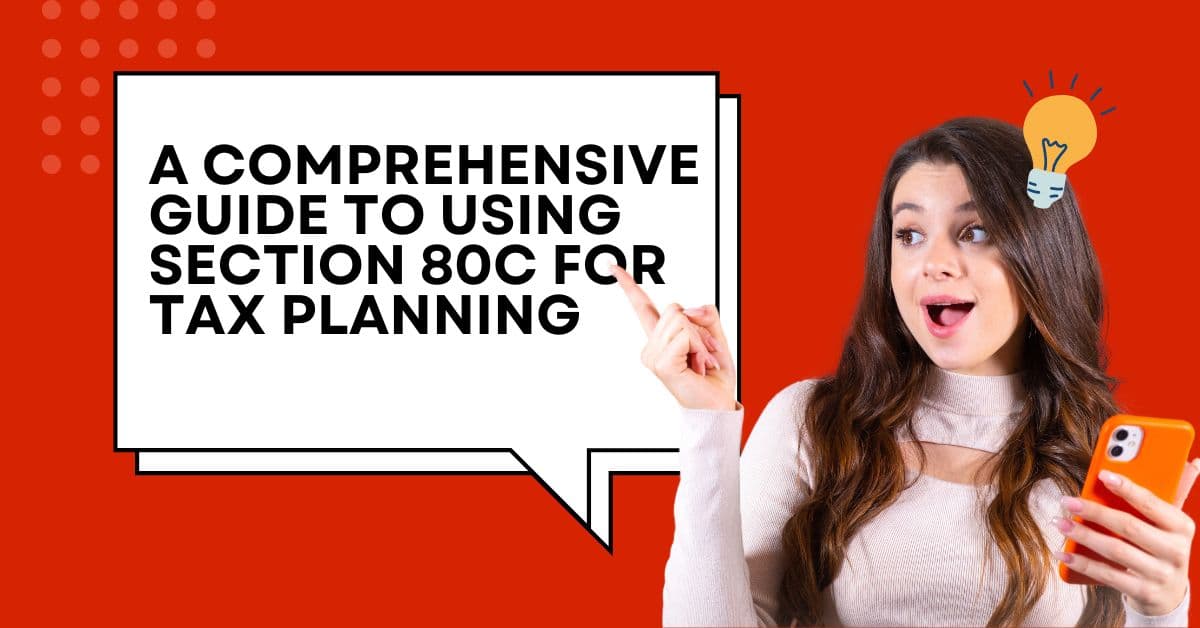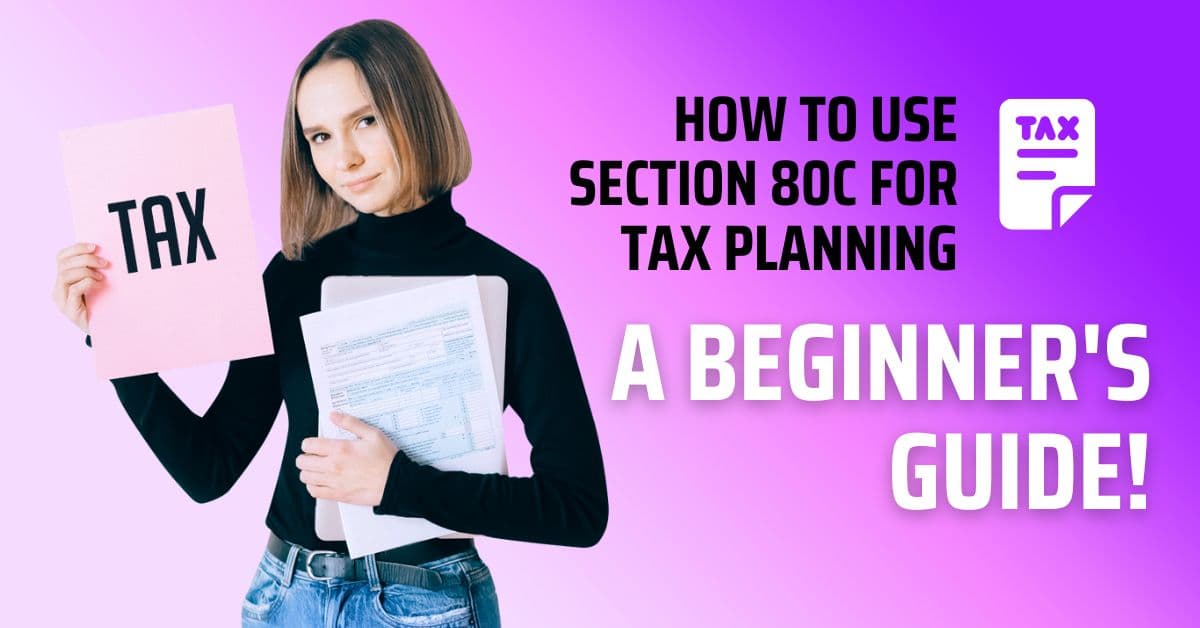How to Use Section 80C for Tax Planning: If you’re new to handling your finances in India, tax planning may seem complicated. Due to growing expenses, people on salaries, small company owners, and even independent contractors are often searching for lawful ways to lower their tax obligations. Section 80C of the Income Tax Act, 1961, is one of your most effective weapons as it permits you to deduct up to ₹1.5 lakh per year from certain investments and expenses. With an estimated 70 million taxpayers in India as of March 31, 2025, and mutual fund SIPs totalling ₹20,000 crore per month, Section 80C continues to be a vital component of tax-saving tactics.
What is Section 80C?
A deduction of up to ₹1.5 lakh per fiscal year for investments and expenses in specific instruments is provided to taxpayers by Section 80C of the Indian Income Tax Act. It applies to individuals and Hindu Undivided Families (HUFs) under the previous tax regime and was introduced to promote savings and financial stability (the new regime started in 2020, thus it is optional). You can reduce your taxable income and, consequently, your tax liability by investing in or spending money on Section 80C-eligible securities.

For instance, if you invest ₹1.5 lakh under Section 80C and earn ₹8 lakh a year, your taxable income decreases to ₹6.5 lakh, which may save you ₹31,200 in taxes (assuming a 20% tax bracket, excluding cess). This is a straightforward, lawful method for novices to develop a solid financial foundation while keeping more of their hard-earned money.
Why Section 80C Is Ideal for Indian Tax Planning
Although India’s tax code might be complicated, Section 80C is a particularly user-friendly choice. It’s perfect for tax planning for the following reasons:
High Deduction Limit: ₹1.5 lakh is a significant amount that covers a variety of costs and investments.
Variety of Options: It offers mutual funds and term deposits to suit a range of risk tolerances and objectives.
Dual Benefit: Tax savings and long-term wealth growth are two benefits.
Accessibility: Open to HUFs, independent contractors, and salaried workers.
Cultural Fit: Promotes responsible financial practices and fits perfectly with India’s savings-focused mentality.
With yearly inflation between 5 and 6% and tax slabs that are regularly discussed in Union Budgets (such as those for 2025), Section 80C is still a dependable method to protect your future and offset growing expenses.
A Comprehensive Guide to Using Section 80C for Tax Planning
Are you prepared to save money on taxes by utilising Section 80C? Use this comprehensive, easy-to-follow instructions designed just for Indian taxpayers:

- First, ascertain your taxable income.
- Determine your total revenue, including your salary, company earnings, and rental income.
- For instance, a salary of ₹10 lakh per year.
- Verify your tax bracket under the previous system, such as 20% for ₹5–10 lakh + cess.
- Goal: Use Section 80C to lower taxable income by ₹1.5 lakh.
Step 2: Evaluate Your Spending Limit
- Examine your monthly earnings and outlays (such as your ₹20,000 rent and ₹50,000 pay cheque).
- Assess your financial capacity under Section 80C and decide whether to start modest (₹5,000 per month) or go large (₹1.5 lakh in one lump amount).
- Apply the rule of 50-30-20: 20% of income, or ₹10,000, should be set aside for investments or savings like 80C.
Step 3: Finish KYC (if required)
- KYC is required for several 80C investments, such as PPF and mutual funds.
- Send it online via Groww: PAN card applications or CAMS/KFIN.
- Proof of address or Aadhaar.
- Bank account information.
- Verification takes 5–10 minutes and is finished in 1-2 days.
Step 4: Examine Your Options Under Section 80C
Below is a summary of well-liked options:
The Public Provident Fund (PPF) has a minimum of ₹500 and a maximum of ₹1.5 lakh annually.
- Tax-free interest rate of about 7% (2025 rate).
- Lock-in: 15 years.
- Ideal for: Risk-averse, long-term savers.
Equity-Linked Savings Scheme (ELSS): 3-year lock-in mutual funds.
- Returns: 10–15% (depending on the market).
- Minimum: ₹500 (via SIP).
- Ideal for: Those want to grow and have a reasonable amount of risk tolerance.
The National Savings Certificate (NSC) has a ₹100 minimum and a ₹1.5 lakh deductible maximum.
- Interest: about 6.8% (taxable, compounded).
- Duration: 5 years.
- Ideal for: Medium-term, safe savings.
5-Year Bank Fixed Deposit (FD):
- Maximum deductible: ₹1.5 lakh; Minimum varies by bank.
- 5-7% interest is taxed.
- Five-year lock-in.
- Ideal for: Investors that are conservative.
The cost of life insurance premiums for oneself, one’s spouse, or one’s children.
- The maximum deductible is ₹1.5 lakh.
- Ideal for: Tax-savers and insurance-holders.
Employer-matched Employee Provident Fund (EPF):
- 12% of base pay.
- Interest (tax-free): around 8%.
- Ideal for: Automatic deductions for salaried staff.
Principal Repayment for Home Loans:
- The main amount of the EMI.
- The maximum deductible is ₹1.5 lakh.
- Ideal for: Households.
Tuition: The cost of educating children (up to two).
- The maximum deductible is ₹1.5 lakh.
- Ideal for: Parents.
Step 5: Select Your Investment Combination
Align alternatives with your risk tolerance and goals:
- PPF, NSC, and FD (e.g., ₹50,000 each) are low risk.
- PPF + ELSS (e.g., ₹75,000 apiece) = Moderate Risk.
- Current costs include insurance and EPF (e.g., ₹1 lakh + ₹50,000).
For balance, diversify within ₹1.5 lakh.
Step 6: Make an Investment
- PPF: Deposit using net banking after opening at a bank or post office.
- ELSS: Create a SIP (for example, ₹5,000/month) using applications like Groww or Zerodha.
- NSC/FD: Go to the post office or bank.
- Insurance: Purchase insurance online or through a representative.
- EPF: Payslip check; automatic for paid employees.
- Home Loan/Tuition: Present documentation to the employer or teacher.
Step 7: If at all possible, automate
- Establish ELSS SIPs (for example, ₹12,500 per month = ₹1.5 lakh annually).
- Allow PPF or insurance premiums to be deducted automatically.
- assures uniformity and minimises manual labour.
Step 8: Monitor and Record
- Keep track of statements, receipts, and app records (such as the PPF passbook or ELSS NAV).
- Track returns on a quarterly basis—PPF through bank updates, ELSS through applications.
- Keep documentation for your tax returns (Form 16, ITR).
Step 9: Make a Claim
- To modify TDS, provide your employer with evidence (by January 2026 for FY 2025-26).
- Or, by July 31, 2026, submit an ITR (such as an ITR-1) and claim ₹1.5 lakh under Section 80C.
- Make use of websites such as the Income Tax e-filing site or ClearTax.
Step 10: Examine Every year
- Evaluate: Are results fulfilling objectives? (for instance, FD at 6% versus ELSS at 12%).
- Modify: Move money or boost donations for the upcoming fiscal year.
Advantages of Tax Planning using Section 80C Tax Savings:
- Spend no more than ₹46,800 annually (30% slab + cess).
- Building Wealth: Over time, PPF and ELSS increase your money.
- Flexibility: Choices for all tenures and risk levels.
- Legal Compliance: Completely approved by the government.
- Easy for Novices: No knowledge of finance is required.
Examples from Real Life
Sanjay’s Approach to Salary
Sanjay, a thirty-year-old Pune engineer earning ₹8 lakh per year, was able to save ₹31,200:
- PPF of ₹50,000 (7% return).
- ₹50,000 in ELSS (anticipated 12%).
- EPF of ₹50,000 (8% return).
- He claims that Section 80C made his taxes easier.
The Family Plan of Priya
Priya, a 35-year-old Chennai housewife, spent ₹1.5 lakh:
- Insurance of ₹75,000 (self + children).
- Tuition for two children is ₹75,000.
- She explains, “It’s tax saving plus family security.”
Anil’s Priority for Growth
Anil, a 25-year-old Delhi freelancer, wanted to advance:
- ₹1.5 lakh in ELSS SIP (return of 13%, ₹12,500/month).
- developed a corpus and saved ₹15,600 (10% slab).
Tips to Maximise Section 80C for Beginners

- Get Started Early: To optimise results, invest by April 2025 for FY 2025–2026.
- Mix and Match: Put PPF (safety) and ELSS (growth) together.
- Benefits of Employers: EPF maximum if you are salaried.
- Steer clear of overlap: Don’t spend more than ₹1.5 lakh; have a good strategy.
- Keep Up: For revisions (such as new 80C choices), consult Budget 2025.
- Use Apps: Groww and ClearTax apps to file your ITR or ELSS.
Typical Problems and Their Fixes
- Problem: Lock-in periods (such as ELSS 3 years) present a challenge.
Solution: Use liquid alternatives like FD and plan your financial flow. - Problem: Not knowing what to do.
Solution: Diversify after starting with one (like PPF). - Problem: Missing deadlines is a challenge.
Solution: Send out reminders for the proof submission due in January. - Problem: Low returns, such as FD at 6%, provide a challenge.
Solution: To increase growth, add ELSS.
Why Does Section 80C Benefit Indian Beginners?
With 70 million taxpayers and a 15% mutual fund penetration rate, Section 80C connects tax relief and savings. It serves as a springboard for novices to begin investing while adhering to Indian tax regulations.
Get Started with Section 80C Tax Planning Today
Are you prepared to build wealth and reduce taxes? This is your strategy:
- Do your taxable income calculation now.
- By April 5, 2025, select one option (for example, ₹5,000 ELSS SIP).
- Make a ₹1.5 lakh claim for FY 2025–2026.
Your first step towards financial freedom is Section 80C. Spread the tax-saving knowledge by showing your friends and relatives this information!
Capital Gains Tax in India: Everything You Need to Know!
Sensex & Taxes: How to Legally Reduce Your Share Market Tax Burden!
Smart Tax Planning Tips for Small Businesses in India: Save More, Grow Faster!
Tax Planning Objectives Explained: Secure Your Financial Future!

